Challah, a traditional Jewish bread, is often baked in abundance for holidays and Shabbat. There can be times when you have more challah than you can eat before it goes stale. Freezing challah is a great way to preserve its freshness and enjoy it at a later date. Whether you’ve baked it yourself or bought it from a bakery, knowing the right techniques for freezing can make all the difference in maintaining its quality and taste.
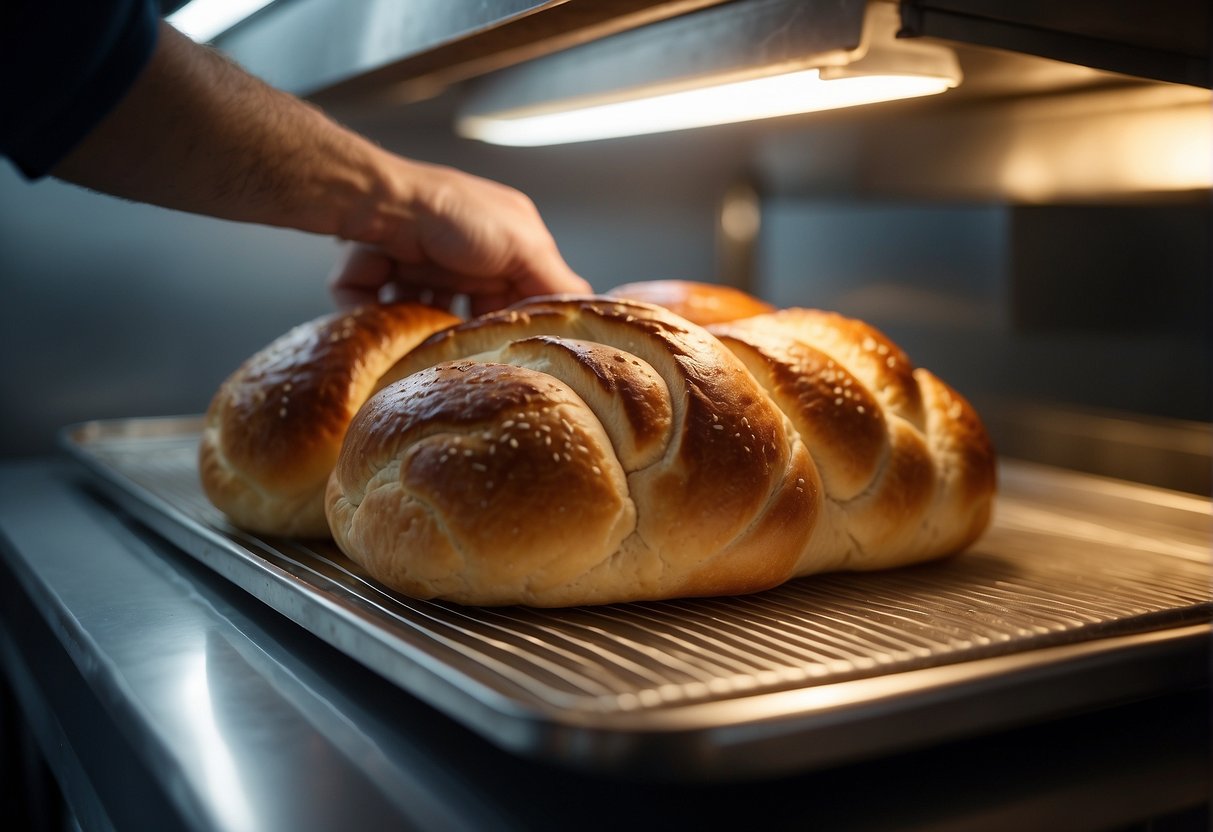
Properly preparing your challah before freezing is vital. Ensure the bread is completely cooled to room temperature to prevent condensation inside the packaging, which can lead to freezer burn. Once cooled, you’ll want to wrap the challah thoroughly. Using plastic wrap, foil, or a freezer-safe bag will protect the bread from air exposure and help maintain its moisture. This method allows you to keep challah for weeks or even months without significant loss of flavor or texture.
When you are ready to enjoy your challah again, knowing the best way to thaw and reheat will ensure that it tastes as good as the day it was baked. A controlled thawing process at room temperature or in the refrigerator can retain the bread’s qualities. Reheating it properly will revive the crust’s crispness and the interior’s softness, making your challah an enjoyable accompaniment to any meal once again.
Key Takeaways
- Preserving challah’s freshness for later use is easily managed by freezing it.
- Wrapping challah properly before freezing helps maintain its quality and taste.
- Controlled thawing and proper reheating are crucial to reviving frozen challah’s texture and flavor.
Choosing the Right Challah

When preparing to freeze challah, selecting a loaf that will maintain its taste and texture after thawing is crucial.
Selecting Freshness and Quality
You want to start with a challah that is at its peak of freshness. A fresh loaf should have a glossy, golden crust and a soft, springy texture. Look for these signs to ensure quality:
- Crust: Glossy and golden
- Texture: Soft and springy to the touch
- Aroma: Yeasty and sweet
A visual examination and a gentle squeeze of the bread can help determine its freshness.
Types of Challah
Different types of challah can affect the flavor and suitability for freezing. Here are some typical variants:
- Traditional Egg Challah: Rich and slightly sweet; ideal for a variety of uses.
- Whole Wheat Challah: Denser and heartier, with a nuttier flavor.
- Water Challah: Less rich, made without eggs, often preferred for its lighter texture.
Keep in mind that richer challahs with more eggs and oil tend to freeze and thaw while maintaining a pleasant texture.
Preparation Before Freezing
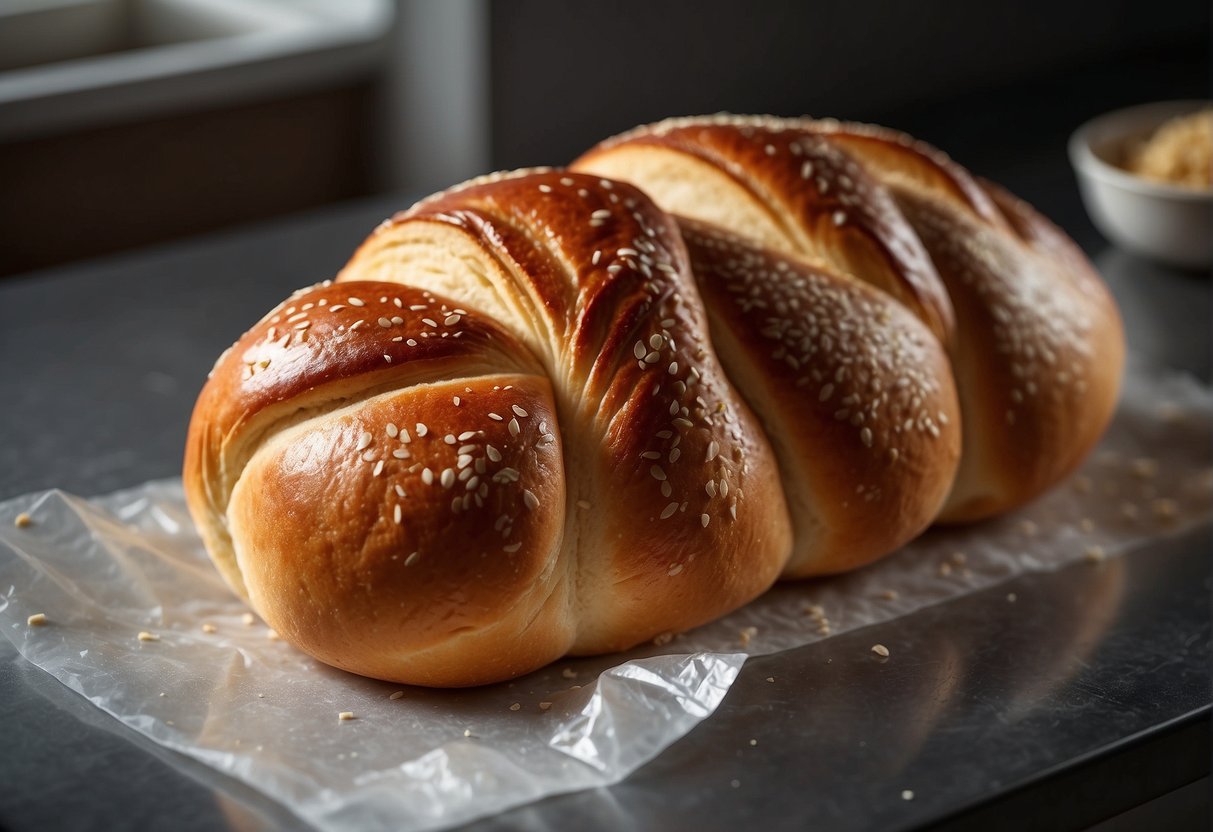
Before you even think about storing your challah in the freezer, it’s important to properly prepare it to maintain its quality and flavor.
Cooling Down
After your challah has finished baking, you must let it cool completely at room temperature. Do not attempt to freeze challah while it’s still warm, as this can result in condensation that leads to freezer burn or mold. This cooling process typically takes about 2 hours. Place the challah on a wire rack to ensure air circulates all around, which helps it cool evenly.
Slicing the Challah
Decide if you’d like to freeze the challah whole or in slices. If you prefer sliced challah for convenience, use a serrated knife to cut even slices. It’s essential to:
- Cut your challah with a gentle sawing motion.
- Aim for slices about 1/2-inch to 3/4-inch thick for ideal defrosting and toasting.
By slicing your challah before freezing, you make it easier to use just the amount you need without defrosting the entire loaf.
Wrapping and Storing Challah
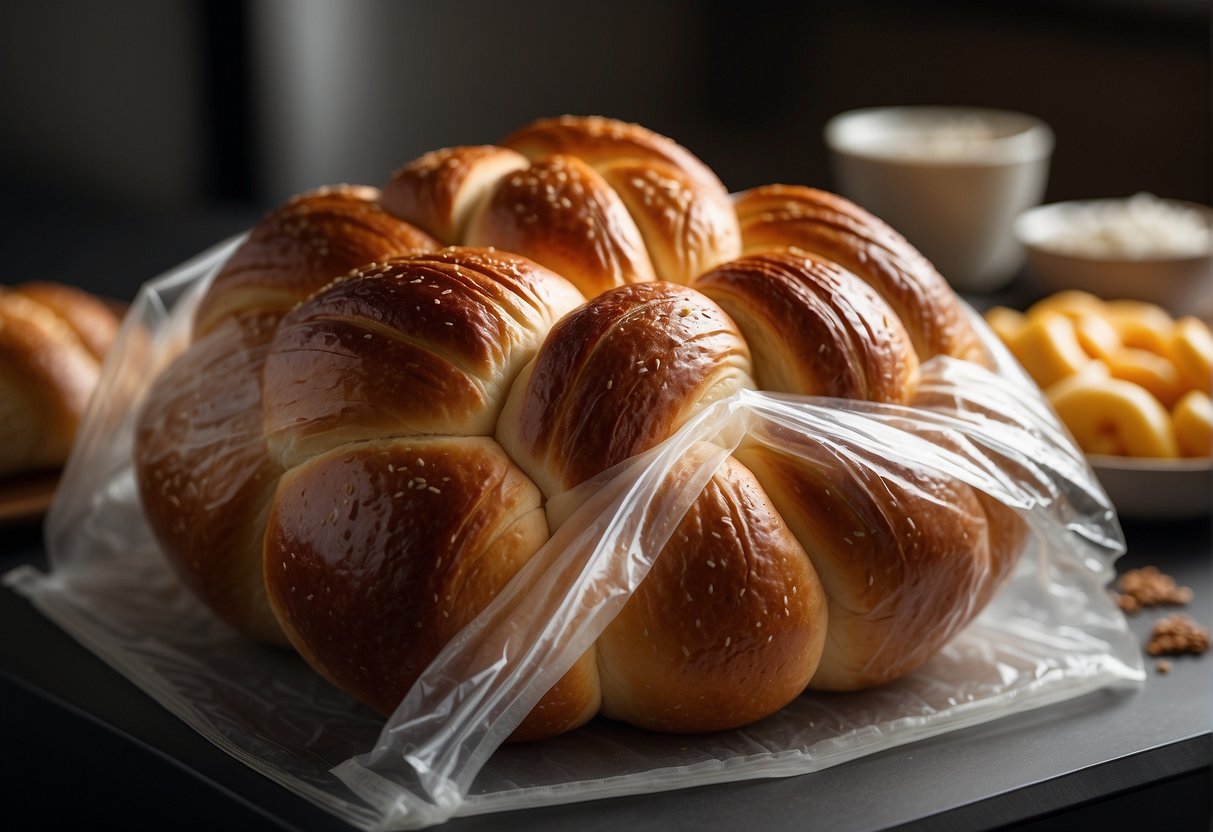
Proper wrapping and storage are essential to maintain the freshness of challah. Both protect its moisture and flavor when freezing.
Materials for Wrapping
- Plastic Wrap: Your challah should be tightly wrapped in plastic wrap to create a moisture barrier. Ensure no part is left uncovered to prevent freezer burn.
- Aluminum Foil: After covering with plastic wrap, encase your challah in aluminum foil for an added layer of protection against odors and temperature fluctuations.
- Freezer Bags: If preferred, you can place the double-wrapped challah into a large freezer bag. Squeeze out excess air before sealing to retain freshness.
Freezer Storage Techniques
- Cool First: Always let your challah cool to room temperature before wrapping to avoid condensation, which can lead to sogginess or mold.
- Label: Use a marker to label the foil with today’s date, Sat Jan 20 2024, so you can track how long your challah has been stored.
- Flat Surface: Place your wrapped challah on a flat surface in the freezer to retain its shape and avoid any pressure points that might cause compaction.
- Thawing: When ready to use, thaw your challah in the refrigerator overnight while still wrapped to reduce condensation and maintain the original texture.
Thawing and Reheating
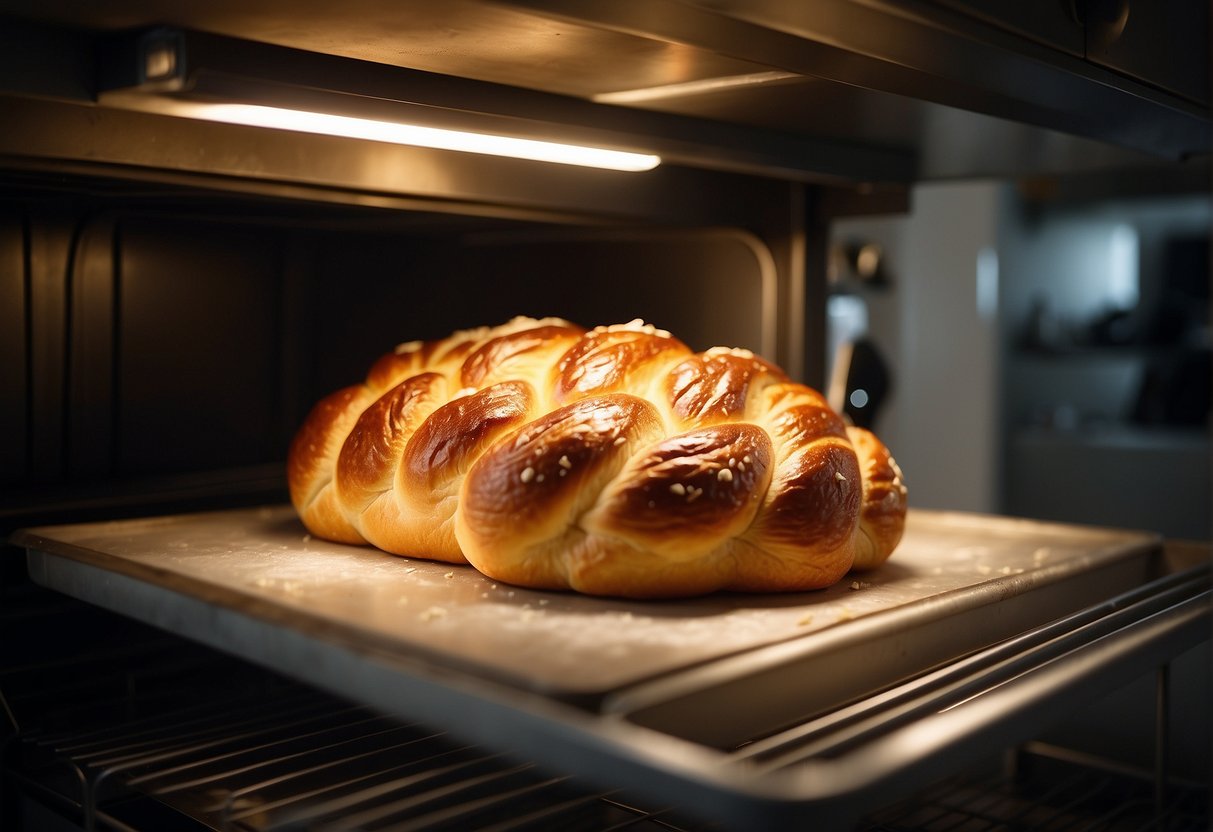
After freezing challah to preserve its freshness, proper thawing and reheating are essential to enjoy its original flavor and texture.
Thawing Challah
To thaw your challah, remove it from the freezer and let it sit at room temperature in its wrapping for several hours, preferably overnight. This slow process helps the challah retain its moisture and prevents it from drying out. Do not attempt to speed up the process by using a microwave, as this can lead to uneven results and a loss of quality.
Reheating Guidelines
Once your challah is fully thawed, you may want to warm it up to enhance its taste and softness. Heat your oven to 350°F (175°C). If the challah is still whole, wrap it in foil and place it in the oven for about 10 minutes. If it’s sliced, you can heat the slices, covered with foil, for 5 minutes. Always check that your challah is warmed throughout but avoid overbaking to maintain its moisture.
Frequently Asked Questions
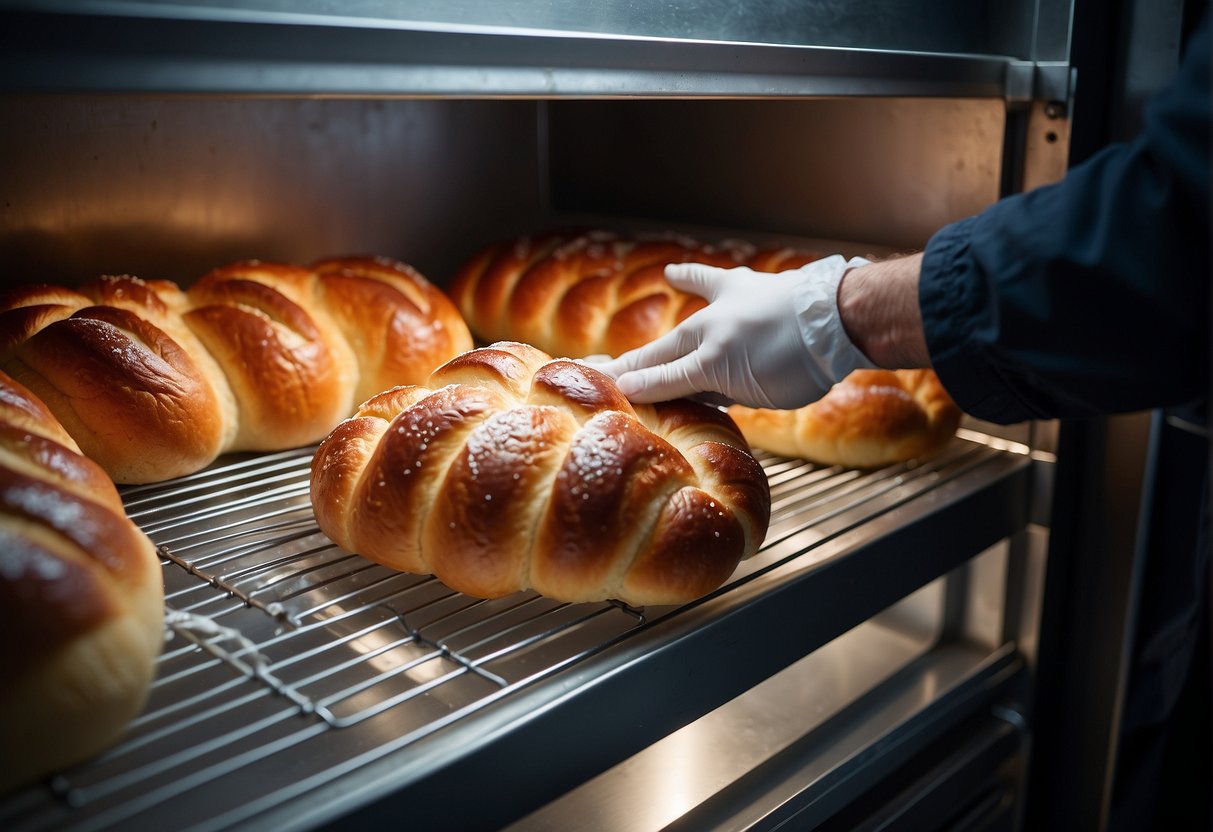
Freezing challah is a great way to extend its freshness, but doing it properly ensures the best results. Below are specific answers to some common questions about freezing and handling challah.
What is the optimal way to store challah in the freezer?
To best store challah in the freezer, cool it completely at room temperature. Wrap it tightly in plastic wrap, then a layer of foil, and place it in a freezer bag to prevent freezer burn and preserve taste.
Can you share tips for defrosting challah quickly without compromising its quality?
To defrost challah quickly, remove it from the freezer and leave it at room temperature, still wrapped, to prevent condensation. For a faster method, thawing in the oven on a low setting works well; keep it in its wrapping to retain moisture.
Is it possible to freeze challah dough, and if so, how should it be done?
Yes, you can freeze challah dough. After the first rise, punch it down, tightly wrap it in plastic wrap, then place it in a freezer bag. Thaw overnight in the refrigerator before shaping, letting it rise again, and baking.
How long can challah bread be kept fresh in the refrigerator before it needs to be frozen?
Challah bread can be kept fresh in the refrigerator for about 2 to 3 days wrapped in plastic. Any longer, and it’s best to freeze it to maintain its quality.
What steps should I follow to bake challah that has been frozen?
When baking frozen challah dough, first thaw it in the refrigerator overnight. Let it come to room temperature, then shape, allow for the final rise, and bake according to your recipe’s instructions.
Can you prepare challah ahead of time, and how do you maintain its freshness if doing so?
Yes, you can prepare challah ahead of time. To keep it fresh, wrap the baked challah in plastic, then foil, and freeze. If using within a few days, store it in an airtight container at room temperature.
